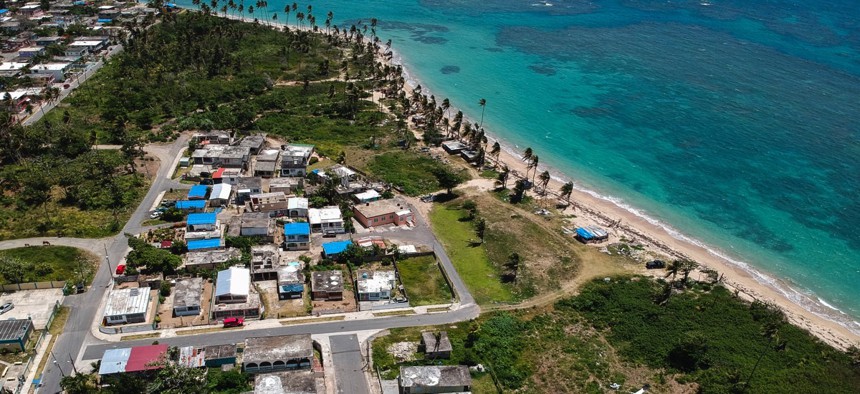Still Rebuilding After Hurricane Maria, Puerto Rico Hopes to Spur Critical Infrastructure Investment

The Viequez neighborhood east of San Juan, Puerto Rico. Thousands of people across the island are still living in damaged homes, protected by blue plastic tarps, nine months after Hurricane Maria hit. Dennis Rivera / AP Photo
Officials have outlined an ambitious set of P3 projects supporting electrical and water resilience, as well as economic development.
OXON HILL, Md. — With power almost completely restored along Puerto Rico’s still-fragile electrical grid nine months after Hurricane Maria, island officials have turned their attention toward securing investment in resilient infrastructure.
The fiscal plan recently certified by the Puerto Rico Financial Oversight and Management Board forecasts about $60 billion in federal funds flowing through the U.S. territory over the next eight to 10 years.
Funding like that hasn’t been seen on the island since the 1990s, and Puerto Rican officials at the 2018 SelectUSA Investment Summit just outside Washington, D.C. said Thursday they hoped it would entice other investors.
“I think that Puerto Rico can be a great case study for the Trump administration in how you can use investment in infrastructure to support economic development and also rebuild and modernize aging infrastructure,” Omar Marrero, Puerto Rico Public-Private Partnerships Authority executive director, told Route Fifty.
Gov. Ricardo Roselló on Wednesday announced $1.5 billion in projected investments across six public-private partnership, or P3, projects that officials hope will help the government transfer finance, production and maintenance risks. For comparison, the U.S. P3 market was valued at $2.6 billion in 2016.
Roselló’s administration has moved to overhaul its highly subsidized maritime transportation system—providing ferry service between metro areas and outlying islands—by making it part of the Federal Transit Administration’s pilot program for private investment. The territory is also eying a $50 million to $150 million procurement for on-campus student housing at the University of Puerto Rico Mayagüez Campus.
A third P3 project, costing between $150 million and $400 million, would see the Puerto Rico Aqueduct and Sewer Authority, or PRASA, replace all water metering and externalize non-revenue water—the water lost before reaching the customer. Residents currently pay PRASA’s non-revenue water operational loss, close to 60 percent, but smart metering is expected to help residents identify leaks.
The three other P3 projects have been proposed by the private sector, after Puerto Rico amended its laws to allow for that.
Tesla pitched a high-capacity energy storage system at critical substations, an environmentally friendly alternative to the diesel-fired “peaker” units currently in use. Should another hurricane cause an electrical collapse, the energy stored in giant batteries could be used for power.
Estimates have the Puerto Rico Electric Power Authority, or PREPA, saving $8 million annually from this system.
Roselló signed another law Wednesday that will partially privatize the public electric utility and allow the concession of its energy transformation and distribution system.
Puerto Rico entered into a collaboration agreement with the U.S. Department of Energy to install five microgrids—clusters of independent electricity sources connected to more traditional grids—in industrial parks. The island has more than 200 such industrial parks across 78 cities, so if the pilot attracts outside investment for more microgrids, PREPA could dramatically reduce the cost of energy while improving efficiency and resiliency.
A separate microgrid will be installed in the old naval base at Roosevelt Roads, which already has an independent grid.
And in a “bet for the future,” Puerto Rico is also developing an ocean technology park in the southeast corner of the island to test ocean thermal energy conversion like the kind seen in Hawaii and Japan, said Manuel Laboy, secretary of the Puerto Rico Economic Development and Commerce Department. The technology could spur new industries like aquaculture and biofuels.
“In the next couple years, the infrastructure will be transformed,” Laboy said.
Also under consideration is a P3 proposal from Global Ports Holding, the world’s largest cruise ship port operator, to take over the San Juan Cruise Port.
The sixth P3 project will be a public safety training center, similar to one in Illinois, to equip and train first responders for disasters like Maria, where “government itself was a casualty,” Marrero said.
With Puerto Rican tourism projected ahead of last year’s numbers and new manufacturing, aerospace and hotel arrivals in the works, the island is offering “attractive incentives” to promote those sectors, Laboy said. The film industry is also returning.
But Puerto Rico can only do so much saddled with an electrical system from the 1940s reliant on generation units at 44 years median age, compared to 15 years on the U.S. mainland. Since the hurricane, power has been largely restored, but blackouts remain a persistent problem, NBC reported this week. And more than 5,000 homes are still without power.
Laboy and Marrero said they, along with the governor, see the chance to establish a world-class electrical system using the latest advances in renewable energy while most federal agencies and plenty of nonprofits remain on the island.
“It is truly a blank canvas,” Laboy said. “I don’t think we’ve ever had this opportunity, and I don’t think there’s ever been any jurisdiction in the U.S. that has been in this particular situation—having the will and the determination from both federal and state governments, having the money, having the financing capability and the resources, and having the right policies behind it.”
Dave Nyczepir is a News Editor at Government Executive’s Route Fifty and is based in Washington, D.C.
NEXT STORY: Small town's Alexa skill wins AWS award






